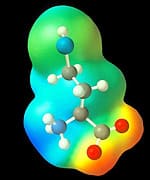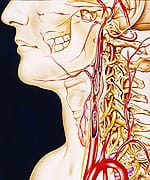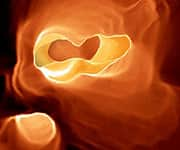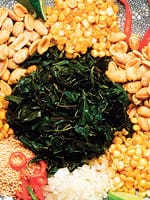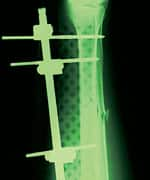Life Extension Magazine®
Scientists have accumulated an immense amount of data associating excessive levels of homocysteine with coronary disease and other pathological conditions. Moreover, emerging research is uncovering important correlations between elevated homocysteine with chronic diseases such as macular degeneration, Alzheimer’s disease, and osteoporosis. In this article, we take a look at established research on the dangers of elevated homocysteine, as well as some of the more recent findings concerning this important marker of cardiovascular health. We also outline strategies that aging adults can use to lower homocysteine naturally, as well as our rationale for pursuing such a preventive approach. Homocysteine is an amino acid that plays key roles in cellular metabolism and protein manufacture. At elevated levels in the body, however, homocysteine may have far-reaching, perhaps even deadly consequences, ranging from heart disease and stroke to osteoporosis and depression. It is now widely accepted that food sources alone cannot consistently supply the levels of nutrients necessary to sustain optimal homocysteine metabolism. While the FDA has mandated folic acid fortification in wheat products, that is not nearly enough for many aging adults. Emerging studies are uncovering novel nutritional strategies for lowering high homocysteine levels, offering new possibilities for effective control of this potentially lethal amino acid.
Homocysteine and Vascular Disease RiskFollowing the discovery of homocysteine in 1931, little was known about this amino acid for several decades. This changed in the 1960s, when Dr. Kilmer McCully of Harvard proposed that extraordinarily advanced atherosclerosis observed in children and teenagers suffering from heart attacks and stroke was due to an extreme excess of homocysteine. Blood levels of homocysteine in these unfortunate children ranged as high as 300 micromoles per liter (µmol/L), high enough to be easily detected in the urine, thus the initial misnomer “homocystinuria.” For years after his initial observations in children, and despite intense opposition, Dr. McCully argued that homocysteine was also a major risk factor for heart disease in the broader population. Subsequent studies have confirmed Dr. McCully’s proposition. An epidemiological study has demonstrated that homocysteine levels above 10 µmol/L are associated with an up to threefold increase in heart attack risk.1 Such levels are widespread, occurring in 5-10% of the US population and 40% of patients with vascular disease.2 The risk from homocysteine is “continuous,” having no threshold levels where risk suddenly develops. Instead, the higher your homocysteine level, the greater your risk. Levels commonly thought of as normal because they are average for Americans have been shown to contribute to heart disease and stroke risk. Levels as low as 9 µmol/L carry long-term risk, with risk escalating even more sharply at levels of 15 µmol/L or greater.3 Unfortunately, many blood laboratories still consider “normal” levels to be 5–15 µmol/L. Thus, if your doctor tells you your homocysteine level is “normal,” you should ask, “How normal?” Since Dr. McCully’s initial observations, homocysteine has been tied to a constellation of biochemically related disorders. The lack of deep-pocketed drug company support has, to some degree, slowed the evolution of confirmatory clinical data. However, we are beginning to see the formation of a broad consensus across a variety of disease states. Homocysteine and a deficiency of the nutrients that lower it are taking center stage. Fortunately, treatment to lower excess homocysteine is inexpensive, safe, and readily available. Homocysteine, Plaque, and Arterial InjuryHomocysteine has been implicated in multiple stages of the process leading to coronary and arterial plaque growth and activity. Among the most important of the damaging effects observed are:
Homocysteine is an important marker of increased risk for both carotid and aortic plaque, both of which signal heightened risk for stroke. The higher your homocysteine level, the greater the extent of plaque in the aorta, the large artery that emerges from the heart.27,28 The European Concerted Action Project reported more than a doubling of vascular disease when homocysteine levels exceed 12 µmol/L.29 For patients with coronary artery disease, homocysteine levels of 20 µmol/L or higher predict a startling fivefold higher mortality risk compared to patients with a level of 9 µmol/L.5 Does homocysteine cause heart attacks in humans? Substantial epidemiological observations show that the higher the homocysteine level, the higher the risk of heart attack. For example, a study reported in the New England Journal of Medicine followed 587 people with coronary disease, many of whom had undergone bypass surgery or angioplasty. Over the ensuing five years, the mortality rate of those with homocysteine levels below 9 µmol/L was 3.8%. The mortality rate for those with homocysteine levels of 15 µmol/L or greater was 24.7%—more than six times higher!5 Similar observations have been made in several other large studies.31-33
Gender, Aging, and Other Risk FactorsHomocysteine levels increase gradually as we age, with an abrupt jump in females during the menopausal years. From early adulthood to the age of 60 and above, increases in homocysteine levels of 50–100% are often seen.34 Increases of 2-5 µmol/L are common over several years in both men and women, particularly after the age of 65. Therefore, a single favorable laboratory assessment does not necessarily mean that one’s homocysteine will not rise to dangerous levels several years later. It is advisable to re-test your homocysteine level every year, even if an initial reading is favorable. Certain lifestyle factors may increase the risk of elevated homocysteine levels. Vegetarians, for example, tend to have 20-30% higher homocysteine levels than their meat-eating counterparts. This observation is likely due to less vitamin B12 intake in the vegetarian diet.35-36 Smoking, excessive coffee consumption (more than 5-6 cups daily), and alcohol abuse can also raise homocysteine.37 Elevated homocysteine levels take on special significance in the presence of other risk factors for vascular disease. For example, Dutch researchers have shown that while a 5-µmol/L increase in homocysteine in non-diabetics confers a 38% greater risk of cardiovascular disease, the same 5-µmol/L increase in diabetics carries a 238% greater risk!38 People who smoke have a tremendously magnified risk of cardiovascular disease in the presence of higher homocysteine levels. One study from Europe showed a 12-fold higher risk for cardiovascular disease in smokers with homocysteine levels above 12 µmol/L.39 Other data show that the higher your homocysteine, the more it increases the dangers of other risk factors such as high cholesterol, magnifying risk several-fold.39 A particularly lethal combination of risk factors is a high homocysteine level (in this study, above 12 µmol/L for females and greater than 15 µmol/L for males) combined with a lipoprotein(a) level of greater than 40 mg/dL.40 Does Treatment Reduce Risk?Researchers in Ontario, Canada, reported that a homocysteine level above 14 µmol/L identified a group showing much more rapid growth of carotid plaque; however, treatment with 2500 mcg of folic acid, 25 mg of vitamin B6, and 250 mcg of vitamin B12 daily completely eliminated any further plaque growth.41 Dutch researchers have reported extensively on treating high homocysteine levels using folic acid and vitamin B6 in patients with peripheral arterial disease (usually of the leg arteries), demonstrating reduction of heart attack risk and slowed growth of carotid and leg artery plaque.42,43 In a Swiss study, 553 patients were given a placebo or 1000 mcg of folic acid, 10 mg of B6, and 400 mcg of B12 daily following coronary angioplasty. After six months, 9.9% of the patients receiving the B vitamins had to undergo a repeat procedure for re-growth of blockage or a new blockage, while 16.0% of placebo patients required another procedure. Overall cardiac events, including death, were reduced from 22.8% in the placebo group to 15.4% in the B-vitamin group. Interestingly, both groups started with a homocysteine level of only 11.0 µmol/L, which was reduced to 7.2 µmol/L with B vitamins.44 Another trial of folic acid alone (5 mg daily) versus placebo in 283 Dutch patients—all heart attack survivors—yielded conflicting results. All the participants took a cholesterol-lowering medication along with folic acid or placebo. This trial revealed no benefit of folic acid in addition to the cholesterol drug over a one-year period.45
A carotid ultrasound study showed that supplementation with 2500 mcg of folic acid, 25 mg of vitamin B6, and 250 mcg of vitamin B12 daily achieved modest regression of carotid plaque. Two groups were examined: those with baseline homocysteine levels above 14 µmol/L and those with levels below 14 µmol/L. Participants with higher homocysteine levels achieved greater regression using supplements, but even the group with initial levels below 14 µmol/L obtained plaque regression, suggesting that ideal homocysteine levels are well below 14 µmol/L.41 A study from Wake Forest University produced somewhat conflicting results. A comparison of a so-called “high-dose” B-vitamin formulation of 2500 mcg of folic acid, 25 mg of vitamin B6, and 400 mcg of vitamin B12 versus a “low-dose” regimen of 200 mcg of folic acid, 0.2 mg of B6, and 6 mcg of B12 showed no difference in stroke or heart attack risk over two years. In this study comparing “low-dose” to “high-dose” vitamins, the baseline average homocysteine reading was 13.4 µmol/L of blood. The “low-dose” vitamin group experienced very little change in homocysteine levels after two years. The so-called “high-dose” arm (which did not provide particularly high doses) declined from the baseline of 13.4 µmol/L to 11.0 µmol/L. This decline was not enough to bring these so-called “high-dose” subjects into the safe homocysteine range needed to reduce stroke risk.46 Despite the strong epidemiological association between homocysteine and heart attack and stroke risk, the treatment trials still need to better define how best to manage vitamin replacement. Studies that include participants with higher homocysteine levels are needed in order to generate statistically meaningful results. Most of the participants in studies that failed to show benefit had low homocysteine levels. It is therefore no surprise that a treatment benefit over a brief time period might not be measured. Imagine giving an antibiotic to people whether or not they had an infection. No benefit would likely be measured because of a dilutional effect of treating people without infection. Additional trials may shed further light on these questions. However, the association between homocysteine and disease is so overwhelmingly strong that most authorities agree that treatment is readily justified and advisable. | |||||||
Ways to Lower Homocysteine NaturallyThe potential benefits of nutritional homocysteine control are great, while the dangers are virtually nonexistent. Based on the weight of accumulated evidence, our clinic advocates lowering homocysteine levels above 7-8 µmol/L using a graded dosing of three B vitamins, up to maximum doses of 5000 mcg of folic acid, 100 mg (occasionally even 500 mg under a doctor’s supervision) of vitamin B6, and up to 1000 mcg of vitamin B12. Our treatment goal is to lower homocysteine to below 7 µmol/L. We also advocate using choline and trimethylglycine (TMG or betaine) from food or nutritional supplements to augment the benefits of B vitamins and to more effectively suppress the after-meal surge in homocysteine that is not fully controlled by vitamins alone. Your choices for controlling homocysteine include: • Folic acid. Folic acid is the most important factor in controlling homocysteine. Although the US recommended daily allowance (RDA) for adults is only 400 mcg,47 extensive survey data showed that an extraordinary 88% of US adults have a folic acid intake below the RDA.48 Low folic acid intake by pregnant women carries a particularly dire risk, causing devastating neural tube defects in newborns. Low folic acid intake from diet is a growing problem because of food processing. This prompted the FDA to mandate folic acid fortification in enriched grain products. Fortification provides an estimated extra 100 mcg of folic acid daily for most adults and does indeed result in modest reductions of about 0.5 µmol/L in homocysteine. Nonetheless, obtaining sufficient quantities of folate (the food form of folic acid) from foods is difficult, and the majority of Americans not taking folic acid supplements have sufficiently low blood levels that allow higher homocysteine levels.49 Keep in mind that folic acid supplements are twice as bioavailable as folate from food.50 For example, 200 mcg of a folic acid supplement (as an individual supplement or added to grains) provides the same active quantity as 400 mcg of naturally occurring folate from food.51 If you do not eat grain products or you have a higher level of homocysteine, specific folic acid supplementation beyond that in your diet will be necessary. A daily folic acid dose of 800 mcg may lower homocysteine by around 25%.52-53 However, some doctors prescribe folic acid doses up to 5000 mcg for highly elevated homocysteine levels. • Vitamin B12. Vitamin B12 deficiency is common and can contribute to rising homocysteine, particularly in people over 65. In rare cases, replacing folic acid alone can mask a latent B12 deficiency, resulting in nervous system disorders. As a general rule, vitamin B12 and folic acid should be replaced together to maximize their homocysteine-lowering effects. Absorption of B12 is a little tricky, and in the past, physicians simply injected B12. However, more recent data suggest that a dose of 500-2000 mcg is every bit as good as an injection.54 A recent dose-exploring trial established that even 500 mcg of B12 achieves the same effect in correcting B12 deficiency as injectable forms. If you are not B12 deficient (discuss this with your doctor), then lesser doses are sufficient. Our clinic commonly advises patients to take 250 mcg of B12 along with folic acid, a dose that provides about two thirds of the effectiveness of the higher doses.54 • Vitamin B6. Taken along with folic acid, vitamin B6 is effective in blocking post-meal surges of homocysteine, particularly when methio-nine-rich meats are part of the meal. Low blood levels of B6 are common, especially in people with higher homocysteine levels.55 The precise dose of B6 required for maximum homocysteine lowering has been controversial, with doses of 2–50 mg commonly used in clinical studies. However, Dutch researchers who have extensive experience with homocysteine-lowering therapies routinely use 250 mg of B6 without ill effect.43,56,57 High-dose vitamin B6 (100-500 mg per day) has been used successfully in managing perimenstrual symptoms and carpal tunnel syndrome.58 However, in rare cases, higher doses may cause nervous system dysfunction (peripheral neuropathy).58 Most reported cases of neuropathy associated with vitamin B6 supplementation involved intake of 500 mg or more daily for two years or more.59 Vitamin B6 doses higher than 100 mg should therefore be used only under medical supervision. The vast majority of people obtain substantial homocysteine-lowering effects with 50-100 mg per day, provided folic acid is at optimal levels.
• Trimethylglycine (TMG). Also commonly known as betaine, TMG is a constituent of food. The average American ingests 500–2000 mg of TMG a day. Supplemental TMG reduces homocysteine starting at a dose of 1000 mg a day, up to a maximum 20% reduction at 6000 mg per day, the dose often used in severe homocysteine disorders.60 TMG is the most effective nutritional agent for suppressing the after-meal surge in homocysteine, slashing levels up to 50%.60-62 We commonly use 2000 mg per day as a starting dose for fasting homocysteine levels that do not fully respond to the three B vitamins, using higher doses for the after-meal surge seen with methionine loading. Spinach and wheat germ are two particularly rich food sources of TMG. Be aware that the 6000-mg dose of TMG has been found to raise LDL by around 10%,63 and LDL should therefore be monitored when using this high dose of TMG. • Choline. Choline is directly converted to TMG in the body. Choline is readily available in various foods and also as a nutritional supplement. Most people ingest 300-1000 mg a day from dietary sources. Choline has recently gained acceptance as an essential nutrient. To avoid deficiency states, the National Academy of Sciences and the US Institute of Medicine recommend a daily intake of 550 mg for men and 425 mg for women. Higher doses are required to obtain the full benefit of lowering homocysteine. Like TMG, choline has modest effects on fasting homocysteine and a larger effect on the after-meal surge of homocysteine.64 A common dose is 2000-4000 mg per day. • Avoiding methionine-rich foods. Methionine is an amino acid found in food, particularly red meats and dairy products. Although methionine is an essential amino acid, it is also suspected to cause atherosclerotic plaque growth, both directly as well as indirectly by increasing homocysteine levels.65 The US RDA for methionine is 900 mg a day, but the average American takes in a greater quantity of around 2000 mg a day.37 If excess methionine is available in the diet, more homocysteine is produced. This provides the basis for one of the tests for hidden homocysteine excess, the “methionine-loading” test. The after-meal surge in homocysteine is prevented by vitamin B6 availability, along with choline and TMG. • Fish oil. Along with its other remarkable benefits such as lowering triglycerides, reducing fibrinogen, and stabilizing abnormal heart rhythms, fish oil may lower homocysteine. Homocysteine reductions of 36-48% have been reported,66,67 though practical experience suggests a more modest drop of 1-2 µmol/L can be expected. • Taurine. This amino acid and byproduct of methionine metabolism is emerging as a promising agent for reducing the dangers of homocysteine.68 However, further human data are needed to assess its effects. • Exercise. In a cardiac rehabilitation program following bypass surgery, angioplasty, or heart attack, 76 participants experienced a modest 12% reduction in homocysteine just by engaging in a modest program of regular exercise. How or why exercise results in such a reduction is unclear, but this is yet another example of how physical activity yields broad health-promoting benefits.69
Homocysteine, Mood, and MemoryHomocysteine plays an important role in depression. Poor response to antidepressant medication, dysthymia (a lesser form of depression), and full-fledged depression have all been linked to low folic acid levels, which are often accompanied by high homocysteine levels.71 Other studies suggest that higher homocysteine levels are very prevalent among the depressed, with up to 50% of subjects exhibiting homocysteine levels above 10 µmol/L.72,73
Antidepressant medications may have limited effectiveness in treating depression, which may, however, respond to folic acid. Studies have firmly established that folic acid replacement, resulting in reduced homocysteine blood levels, is an important treatment for depression. In an Italian study, folic acid supplementation yielded improvements in mood similar to those produced by the use of conventional antidepressants.74 Moreover, several studies have shown that response to prescription antidepressants like fluoxetine (Prozac®) is substantially improved by taking as little as 500 mcg of folic acid per day.75,76 Although few psychiatrists have added folic acid to their antidepressant treatment protocols, the data suggest that this simple, inexpensive treatment should be a part of every depressed person’s panel of therapies. Doses of 1000-5000 mcg are most effective, generally along with 25-100 mg of vitamin B6 and 100-500 mcg of vitamin B12. There is a growing appreciation of the role of folic acid, vitamins B6 and B12, and homocysteine in the cognitive decline associated with aging. It is well established that diminished memory and cognitive function are associated with deficiencies of these B vitamins and higher homocysteine levels.77,78 An MRI study showed that lower folic acid blood levels were associated with markers of neuropathology in the portion of the brain responsible for higher mental function.79 Last year, Italian researchers reported on the relationship between homocysteine, dementia, and Alzheimer’s disease. For four years, the investigators followed a group of 816 dementia-free adults, averaging 74 years of age. During this interval, 112 subjects developed dementia, including 70 who were diagnosed with Alzheimer’s disease. Individuals who had baseline homocysteine values of greater than 15 µmol/L had a twofold greater risk of developing dementia, and their risk of developing Alzheimer’s disease was more than two times higher than in subjects with lower homocysteine values. The scientists concluded that elevated homocysteine is an independent risk factor for developing dementia and Alzheimer’s disease.80 Homocysteine, Bone Density, and OsteoporosisHomocysteine may play a role in bone density and the risk of osteoporotic fractures, according to emerging findings.81-83 Researchers examined the association between homocysteine concentration and the risk of hip fracture in over 2,000 men and women, aged 59-81, enrolled in the Framingham Study.81 Blood samples from the participants were collected between 1979 and 1982, and were analyzed for homocysteine concentration. The participants were followed through June 1998 for incident hip fracture. Men and women in the highest quartiles of homocysteine concentration experienced a greater risk of hip fracture than those in the lowest quartile—the risk was almost four times higher for men and nearly two times greater for women. The investigators concluded that homocysteine concentration, which can easily be modified with nutritional intervention, is an important risk factor for hip fracture in middle-aged and elderly adults.81
Another study confirmed the relationship between elevated homo-cysteine levels and osteoporotic fractures in older adults. Dutch researchers followed over 2,000 men and women over the age of 55 for five to eight years.82 They determined that an increased level of homocysteine was a strong risk factor for osteoporotic fracture in both men and women. Their research suggests that the risk posed by elevated homocysteine is independent of other factors such as bone mineral density.82 Subsequent research, however, suggests a relationship between homocysteine and bone density. Researchers from Tufts University investigated the relationship between homocysteine, measures of folate and vitamin B12, and bone mineral density in adults aged 55 and older.83 They found that individuals with serum homocysteine levels equal to or above 20 µmol/L had significantly lower bone mineral density than subjects with homocysteine levels below 10 µmol/L, as determined by DEXA hip scans. The investigators also found a relationship between bone density and methylmalonic acid, which is a measure of tissue vitamin B12 status. Elevated levels of methylmalonic acid, indicating low tissue levels of vitamin B12, were associated with decreased bone mineral density and an increased prevalence of osteoporosis. The researchers concluded that elevated homocysteine and decreased vitamin B12 status were associated with decreased bone mineral density in older adults. In this study, serum and red blood cell folate levels were not related to bone mineral density or osteoporosis.83 In another recent study, the combination of vitamin B12 and folate helped decrease homocysteine levels and prevent hip fractures in individuals who had previously suffered a stroke.84 Elevated homocysteine is a risk factor for both ischemic stroke and osteoporotic fracture in men and women. Over 500 male and female stroke survivors suffering from residual partial paralysis were supplemented with 5000 mcg of folate and 1500 mcg of vitamin B12 or placebo for two years. At baseline, all the patients had high levels of homocysteine and low serum levels of vitamin B12 and folate. At the two-year follow-up, homocysteine levels increased 31% in the placebo group and fell 38% in the B12-folate group. The B12-folate group also experienced a decreased rate of hip fracture compared to the placebo group. The researchers concluded that supplementing with vitamin B12 and folate is safe and effective in reducing hip fracture risk in elderly patients following a stroke.84
Managing elevated homocysteine may thus be an important strategy for preserving bone mineral density, minimizing osteoporosis risk, and preventing bone fractures.81-84 While numerous nutritional remedies may be helpful for reducing homocysteine levels, vitamin B12 may play an especially important role in promoting healthy bone mineral density,83 and the combination of B12 and folate may reduce hip fracture risk following a stroke.84 The mechanism by which homocysteine affects bone density and fracture risk remains unknown, but some investigators speculate that high serum homocysteine concentration may weaken bone by interfering with collagen cross-linking, thus increasing the risk of osteoporotic fracture.81 Emerging research relates deficient folate and high homocysteine levels with such disparate conditions as complications of pregnancy, inflammatory bowel disease, and some cancers.85-87 Although we await data demonstrating just how supplementation benefits these conditions, the ease of nutritional intervention argues for simply correcting elevated levels of homocysteine, drawing on the compelling knowledge base already established. ConclusionHomocysteine is an amino acid that, even at levels previously regarded as normal, exaggerates the adverse effects of other atherosclerotic risk factors and may heighten long-term risk for heart attack, stroke, osteoporosis, depression, blood clot formation, and even cancer. Fortunately, the nutritional management of elevated homocysteine levels is a relatively straightforward proposition. Despite the government’s well-intended mandate to add folic acid to grain products, most of us are still marginally and sometimes substantially deficient of folic acid. Folic acid supplementation, along with other nutritional strategies to lower homocysteine—using vitamins B6 and B12, choline, and trimethylglycine (TMG)—can provide powerful protection against homocysteine’s ill effects on your life and health. Dr. William Davis is an author, lecturer, and cardiologist practicing in Milwaukee, WI. He is founder of Track Your Plaque, a heart disease prevention program that shows how to use the CT scans to control coronary plaque. | ||||||||||||||||||||||||||||||||||||||||||||||||||||||||||||||||||||||||||||||||||||||||||||||||||||||||||
| References | ||||||||||||||||||||||||||||||||||||||||||||||||||||||||||||||||||||||||||||||||||||||||||||||||||||||||||
| 1. Stampfer MJ, Malinow MR, Willett WC, et al. A prospective study of plasma homocyst(e)ine and risk of myocardial infarction in US physicians. JAMA. 1992 Aug 19;268(7):877-81. 2. Stanger O, Herrmann W, Pietrzik K, et al. Clinical use and rational management of homocysteine, folic acid, and B vitamins in cardiovascular and thrombotic diseases. Z Kardiol. 2004 Jun;93(6):439-53. 3. Nygard O, Nordrehaug JE, Refsum H, et al. Plasma homocysteine levels and mortality in patients with coronary artery disease. N Engl J Med. 1997 Jul 24;337(4):230-6. 4. Tyagi SC. Homocysteine redox receptor and regulation of extracellular matrix components in vascular cells. Am J Physiol. 1998 Feb;274(2 Pt 1):C396-C405. 5. Taha S, Azzi A, Ozer NK. Homocysteine induces DNA synthesis and proliferation of vascular smooth muscle cells by a hydrogen peroxide-independent mechanism. Antioxid Redox Signal. 1999;1(3):365-9. 6. Kartal ON, Negis Y, Aytan N. Molecular mechanisms of cholesterol or homocysteine effect in the development of atherosclerosis: Role of vitamin E. Biofactors. 2003;19(1-2):63-70. 7. Zeng XK, Guan YF, Remick DG, Wang X. Signal pathways underlying homocysteine-induced production of MCP-1 and IL-8 in cultured human whole blood. Acta Pharmacol Sin. 2005 Jan;26(1):85-91. 8. Zeng XK, Remick DG, Wang X. Homocysteine induces production of monocyte chemoattractant protein-1 and interleukin-8 in cultured human whole blood. Acta Pharmacol Sin. 2004 Nov;25(11):1419-25. 9. Auer J, Berent R, Lassnig E, Eber B. C-reactive protein and coronary artery disease. Jpn Heart J. 2002 Nov;43(6):607-19. 10. Higuchi M, Castelli JB, Aiello VD, et al. Great amount of C.pneumoniae in ruptured plaque vessel segments at autopsy. A comparative study with stable plaques. Arq Bras Cardiol. 2000 Feb;74(2):149-51. 11. Sacks FM, Moye LA, Davis BR, et al. Relationship between plasma LDL concentrations during treatment with pravastatin and recurrent coronary events in the Cholesterol and Recurrent Events trial. Circulation. 1998 Apr 21;97(15):1446-52. 12. Rubins HB, Robins SJ, Collins D, et al. Distribution of lipids in 8,500 men with coronary artery disease. Department of Veterans Affairs HDL Intervention Trial Study Group. Am J Cardiol. 1995 Jun 15;75(17):1196-201. 13. Voutilainen S, Morrow JD, Roberts LJ, et al. Enhanced in vivo lipid peroxidation at elevated plasma total homocysteine levels. Arterioscler Thromb Vasc Biol. 1999 May;19(5):1263-6. 14. Sainani GS and Sainani R. Homocysteine and its role in the pathogenesis of atherosclerotic vascular disease. J Assoc Physicians India. 2002 May;50 Suppl16-23. 15. Laaksonen R, Janatuinen T, Vesalainen R, et al. High oxidized LDL and elevated plasma homocysteine contribute to the early reduction of myocardial flow reserve in healthy adults. Eur J Clin Invest. 2002 Nov;32(11):795-802. 16. Shatrov VA, Brune B. Induced expression of manganese superoxide dismutase by non-toxic concentrations of oxidized low-density lipoprotein (oxLDL) protects against oxLDL-mediated cytotoxicity. Biochem J. 2003 Sep 1;374(Pt 2):505-11. 17. Scaramella JG. Hyperhomocysteinemia and left internal jugular vein thrombosis with Meniere’s symptom complex. Ear Nose Throat J. 2003 Nov;82(11):856, 859-60, 65. 18. Sauls DL, Wolberg AS, Hoffman M. Elevated plasma homocysteine leads to alterations in fibrin clot structure and stability: implications for the mechanism of thrombosis in hyperhomocysteinemia. J Thromb Haemost. 2003 Feb;1(2):300-6. 19. Ebbesen LS, Christiansen K, Ingerslev J. Hyperhomocysteinemia due to folate deficiency is thrombogenic in rats. J Nutr. 2003 Jul;133(7):2250-5. 20. Al-Obaidi MK, Philippou H, Stubbs PJ, et al. Relationships between homocysteine, factor VIIa, and thrombin generation in acute coronary syndromes. Circulation. 2000 Feb 1;101(4):372-7. 21. Khajuria A, Houston DS. Induction of monocyte tissue factor expression by homocysteine: a possible mechanism for thrombosis. Blood. 2000 Aug 1;96(3):966-72. 22. Derbeneva SA, Pogozheva AV. Homocysteine as a coronary risk factor. Vopr Pitan. 2003;72(5):43-8. 23. Debreceni L. Homocysteine—a risk factor for atherosclerosis. Orv Hetil. 2001 Jul 8;142(27):1439-44. 24. Magott M. Homocysteine as a nonlipid factor in the pathogenesis of atherosclerosis. Postepy Hig Med Dosw. 1998;52(3):259-67. 25. Lentz SR, Sadler JE. Inhibition of thrombomodulin surface expression and protein C activation by the thrombogenic agent homocysteine. J Clin Invest. 1991 Dec;88(6):1906-14. 26. Hayashi T, Honda G, Suzuki K. An atherogenic stimulus homocysteine inhibits cofactor activity of thrombomodulin and enhances thrombomodulin expression in human umbilical vein endothelial cells. Blood. 1992 Jun 1;79(11):2930-6. 27. Tribouilloy CM, Peltier M, Iannetta Peltier MC, et al. Plasma homocysteine and severity of thoracic aortic atherosclerosis. Chest. 2000 Dec;118(6):1685-9. 28. Lentz SR, Rodionov RN, Dayal S. Hyperhomocysteinemia, endothelial dysfunction, and cardiovascular risk: the potential role of ADMA. Atheroscler Suppl. 2003 Dec;4(4):61-5. 29. Graham IM, Daly LE, Refsum HM, et al. Plasma homocysteine as a risk factor for vascular disease. The European Concerted Action Project. JAMA. 1997 Jun 11;277(22):1775-81. 30. Rasouli ML, Nasir K, Blumenthal RS, et al. Plasma homocysteine predicts progression of atherosclerosis. Atherosclerosis. 2005 Jul;181(1):159-65. 31. Mayer EL, Jacobsen DW, Robinson K. Homocysteine and coronary atherosclerosis. J Am Coll Cardiol. 1996 Mar 1;27(3):517-27. 32. Anon. Homocysteine and risk of ischemic heart disease and stroke: a meta-analysis. JAMA. 2002 Oct 23;288(16):2015-22. 33. Refsum H, Ueland PM, Nygard O, Vollset SE. Homocysteine and cardiovascular disease. Annu Rev Med. 1998;49:31-62. 34. Selhub J, Jacques PF, Rosenberg IH, et al. Serum total homocysteine concentrations in the third National Health and Nutrition Examination Survey (1991-1994): population reference ranges and contribution of vitamin status to high serum concentrations. Ann Intern Med. 1999 Sep 7;131(5):331-9. 35. Mann NJ, Li D, Sinclair AJ, et al. The effect of diet on plasma homocysteine concentrations in healthy male subjects. Eur J Clin Nutr. 1999 Nov;53(11):895-9. 36. Krajcovicova-Kudlackova M, Blazicek P, Kopcova J, Bederova A, Babinska K. Homocysteine levels in vegetarians versus omnivores. Ann Nutr Metab. 2000;44(3):135-8. 37. Chrysohoou C, Panagiotakos DB, Pitsavos C, et al. The associations between smoking, physical activity, dietary habits and plasma homocysteine levels in cardiovascular disease-free people: the “ATTICA” study. Vasc Med. 2004 May;9(2):117-23.3811. 38. Hoogeveen EK, Kostense PJ, Beks PJ, et al. Hyperhomocysteinemia is associated with an increased risk of cardiovascular disease, especially in non-insulin-dependent diabetes mellitus: a population-based study. Arterioscler Thromb Vasc Biol. 1998 Jan;18(1):133-8. 39. O’Callaghan P, Meleady R, Fitzgerald T, Graham I. Smoking and plasma homocysteine. Eur Heart J. 2002 Oct;23(20):1580-6. 40. Hopkins PN, Wu LL, Hunt SC, et al. Lipoprotein(a) interactions with lipid and nonlipid risk factors in early familial coronary artery disease. Arterioscler Thromb Vasc Biol. 1997 Nov;17(11):2783-92. 41. Hackam DG, Peterson JC, Spence JD. What level of plasma homocyst(e)ine should be treated? Effects of vitamin therapy on progression of carotid atherosclerosis in patients with homocyst(e)ine levels above and below 14 micromol/L. Am J Hypertens. 2000 Jan;13(1 Pt 1):105-10. 42. de Jong SC, Stehouwer CD, van den BM, et al. Normohomocysteinaemia and vitamin-treated hyperhomocysteinaemia are associated with similar risks of cardiovascular events in patients with premature peripheral arterial occlusive disease. A prospective cohort study. J Intern Med. 1999 Jul;246(1):87-96. 43. Vermeulen EG, Stehouwer CD, Twisk JW, et al. Effect of homocysteine-lowering treatment with folic acid plus vitamin B6 on progression of subclinical atherosclerosis: a randomised, placebo-controlled trial. Lancet. 2000 Feb 12;355(9203):517-22. 44. Schnyder G, Roffi M, Flammer Y, Pin R, Hess OM. Effect of homocysteine-lowering therapy with folic acid, vitamin B12, and vitamin B6 on clinical outcome after percutaneous coronary intervention: the Swiss Heart study: a randomized controlled trial. JAMA. 2002 Aug 28;288(8):973-9. 45. Liem AH, van Boven AJ, Veeger NJ et al. Efficacy of folic acid when added to statin therapy in patients with hypercholesterolemia following acute myocardial infarction: a randomised pilot trial. Int J Cardiol. 2004 Feb;93(2-3):175-9. 46. Toole JF, Malinow MR, Chambless LE, et al. Lowering homocysteine in patients with ischemic stroke to prevent recurrent stroke, myocardial infarction, and death: the Vitamin Intervention for Stroke Prevention (VISP) randomized controlled trial. JAMA. 2004 Feb 4;291(5):565-75. 47. Dietary reference intakes for thiamin, riboflavin, niacin, vitamin B6, folate, vitamin B12, pantothenic acid, biotin, and choline (1998). US Dept. of Agriculture. 48. Subar AF, Block G, James LD. Folate intake and food sources in the US population. Am J Clin Nutr. 1989 Sep;50(3):508-16. 49. Tucker KL, Mahnken B, Wilson PW, Jacques P, Selhub J. Folic acid fortification of the food supply. Potential benefits and risks for the elderly population. JAMA. 1996 Dec 18;276(23):1879-85. 50. McNulty H, Pentieva K. Folate bioavailability. Proc Nutr Soc. 2004 Nov;63(4):529-36. 51. Oakley GP, Jr. Eat right and take a multivitamin. N Engl J Med. 1998 Apr 9;338(15):1060-1. 52. Durga J, van Tits LJ, Schouten EG, Kok FJ, Verhoef P. Effect of lowering of homocysteine levels on inflammatory markers: a randomized controlled trial. Arch Intern Med. 2005 Jun 27;165(12):1388-94. 53. Lewerin C, Matousek M, Steen G, et al. Significant correlations of plasma homocysteine and serum methylmalonic acid with movement and cognitive performance in elderly subjects but no improvement from short-term vitamin therapy: a placebo-controlled randomized study. Am J Clin Nutr. 2005 May;81(5):1155-62. 54. Eussen SJ, de Groot LC, Clarke R, et al. Oral cyanocobalamin supplementation in older people with vitamin B12 deficiency: a dose-finding trial. Arch Intern Med. 2005 May 23;165(10):1167-72. 55. Robinson K, Arheart K, Refsum H, et al. Low circulating folate and vitamin B6 concentrations: risk factors for stroke, peripheral vascular disease, and coronary artery disease. European COMAC Group. Circulation. 1998 Feb 10;97(5):437-43. 56. Vermeulen EG, Rauwerda JA, van den BM, et al. Homocysteine-lowering treatment with folic acid plus vitamin B6 lowers urinary albumin excretion but not plasma markers of endothelial function or C-reactive protein: further analysis of secondary end-points of a randomized clinical trial. Eur J Clin Invest. 2003 Mar;33(3):209-15. 57. Vermeulen EG, Stehouwer CD, Valk J, et al. Effect of homocysteine-lowering treatment with folic acid plus vitamin B on cerebrovascular atherosclerosis and white matter abnormalities as determined by MRA and MRI: a placebo-controlled, randomized trial. Eur J Clin Invest. 2004 Apr;34(4):256-61. 58. Bernstein AL. Vitamin B6 in clinical neurology. Ann NY Acad Sci. 1990;585:250-60. 59. Bendich A, Cohen M. Vitamin B6 safety issues. Ann NY Acad Sci. 1990;585:321-30. 60. Olthof MR, Verhoef P. Effects of betaine intake on plasma homocysteine concentrations and consequences for health. Curr Drug Metab. 2005 Feb;6(1):15-22. 61. Steenge GR, Verhoef P, Katan MB. Betaine supplementation lowers plasma homocysteine in healthy men and women. J Nutr. 2003 May;133(5):1291-5. 62. Holm PI, Ueland PM, Vollset SE, et al. Betaine and folate status as cooperative determinants of plasma homocysteine in humans. Arterioscler Thromb Vasc Biol. 2005 Feb;25(2):379-85. 63. Olthof MR, Vliet TV, Verhoef P, Zock PL, Katan MB. Effect of homocysteine-lowering nutrients on blood lipids: results from four randomised, placebo-controlled studies in healthy humans. PLoS Med. 2005 May;2(5):e135. 64. da Costa KA, Gaffney CE, Fischer LM, Zeisel SH. Choline deficiency in mice and humans is associated with increased plasma homocysteine concentration after a methionine load. Am J Clin Nutr. 2005 Feb;81(2):440-4. 65. Troen AM, Lutgens E, Smith DE, Rosenberg IH, Selhub J. The atherogenic effect of excess methionine intake. Proc Natl Acad Sci USA. 2003 Dec 9;100(25):15089-94. 66. Olszewski AJ, McCully KS. Fish oil decreases serum homocysteine in hyperlipemic men. Coron Artery Dis. 1993 Jan;4(1):53-60. 67. Moller JM, Nielsen GL, Ekelund S, Schmidt EB, Dyerberg J. Homocysteine in Greenland Inuits. Thromb Res. 1997 May 15;86(4):333-5. 68. Nonaka H, Tsujino T, Watari Y, Emoto N, Yokoyama M. Taurine prevents the decrease in expression and secretion of extracellular superoxide dismutase induced by homocysteine: amelioration of homocysteine-induced endoplasmic reticulum stress by taurine. Circulation. 2001 Sep 4;104(10):1165-70. 69. Ali A, Mehra MR, Lavie CJ, et al. Modulatory impact of cardiac rehabilitation on hyperhomocysteinemia in patients with coronary artery disease and "normal" lipid levels. Am J Cardiol. 1998 Dec 15;82(12):1543-5. 70. Zeisel SH, Mar MH, Howe JC, Holden JM. Concentrations of choline-containing compounds and betaine in common foods. J Nutr. 2003 May;133(5):1302-7. 71. Morris MS, Fava M, Jacques PF, Selhub J, Rosenberg IH. Depression and folate status in the US population. Psychother Psychosom. 2003 Mar;72(2):80-7. 72. Bottiglieri T, Laundy M, Crellin R, et al. Homocysteine, folate, methylation, and monoamine metabolism in depression. J Neurol Neurosurg Psychiatry. 2000 Aug;69(2):228-32. 73. Fava M, Borus JS, Alpert JE, et al. Folate, vitamin B12, and homocysteine in major depressive disorder. Am J Psychiatry. 1997 Mar;154(3):426-8. 74. Passeri M, Cucinotta D, Abate G, et al. Oral 5'-methyltetrahydrofolic acid in senile organic mental disorders with depression: results of a double-blind multicenter study. Aging (Milano.). 1993 Feb;5(1):63-71. 75. Coppen A, Bailey J. Enhancement of the antidepressant action of fluoxetine by folic acid: a randomised, placebo controlled trial. J Affect Disord. 2000 Nov;60(2):121-30. 76. Godfrey PS, Toone BK, Carney MW, et al. Enhancement of recovery from psychiatric illness by methylfolate. Lancet. 1990 Aug 18;336(8712):392-5. 77. Kado DM, Karlamangla AS, Huang MH, et al. Homocysteine versus the vitamins folate, B6, and B12 as predictors of cognitive function and decline in older high-functioning adults: MacArthur Studies of Successful Aging. Am J Med. 2005 Feb;118(2):161-7. 78. Ellinson M, Thomas J, Patterson A. A critical evaluation of the relationship between serum vitamin B, folate and total homocysteine with cognitive impairment in the elderly. J Hum Nutr Diet. 2004 Aug;17(4):371-83. 79. Scott TM, Tucker KL, Bhadelia A, et al. Homocysteine and B vitamins relate to brain volume and white-matter changes in geriatric patients with psychiatric disorders. Am J Geriatr Psychiatry. 2004 Nov;12(6):631-8. 80. Ravaglia G, Forti P, Maioli F, et al. Homocysteine and folate as risk factors for dementia and Alzheimer disease. Am J Clin Nutr. 2005 Sep;82(3):636-43. 81. McLean RR, Jacques PF, Selhub J, et al. Homocysteine as a predictive factor for hip fracture in older persons. N Engl J Med. 2004 May 13;350(20):2042-9. 82. van Meurs JB, Dhonukshe-Rutten RA, Pluijm SM, et al. Homocysteine levels and the risk of osteoporotic fracture. N Engl J Med. 2004 May 13;350(20):2033-41. 83. Morris MS, Jacques PF, Selhub J. Relation between homocysteine and B-vitamin status indicators and bone mineral density in older Americans. Bone. 2005 Jun 8. 84. Sato Y, Honda Y, Iwamoto J, Kanoko T, Satoh K. Effect of folate and mecobalamin on hip fractures in patients with stroke: a randomized controlled trial. JAMA. 2005 Mar 2;293(9):1082-8. 85. Nakano E, Taylor CJ, Chada L, McGaw J, Powers HJ. Hyperhomocystinemia in children with inflammatory bowel disease. J Pediatr Gastroenterol Nutr. 2003 Nov;37(5):586-90. 86. Gurbuz A, Karateke A, Mengulluoglu M. Elevated plasma homocysteine levels in preeclampsia and eclampsia. Int J Gynaecol Obstet. 2004 Nov;87(2):165-6. 87. Stover PJ. Physiology of folate and vitamin B12 in health and disease. Nutr Rev. 2004 Jun;62(6 Pt 2):S3-12. 88. Seddon JM, Gensler G, Klein ML. Evaluation of plasma homocysteine and risk of age-related macular degeneration. Am J Ophthalmol. 2006 Jan;141(1):201-3. 89. Available at: www.miami.com/mld/miamiherald/news/11942690.htm. Accessed June 21, 2005. |

